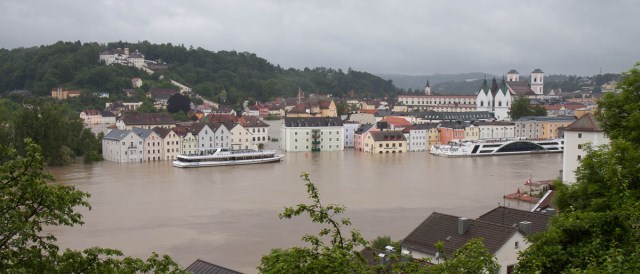For the second time in 11 years, Germany, the Czech Republic, and Austria have experienced a “once-in-a-century flood.” Craig Morris takes a look at how nuclear plants in the area are faring.

Passau, as many cities in southern and eastern Germany, has been particularly severely hit. (Photo by Stefan Penninger, CC BY-SA 2.0)
When German Chancellor Angela Merkel shut down eight of the country’s 17 nuclear plants in March 2011 in reaction to the disaster in Fukushima, her critics ridiculed her for protecting Bavarian nuclear plants from tsunamis. But as I pointed out in March 2013, German nuclear plants are indeed inadequately protected against both earthquakes (which are quite rare in Germany) and flash flooding – which is not rare.
At present, Austria, the Czech Republic, and large parts of Germany (Bavaria, Thüringen, and Saxony) are experiencing a “flood of the century.” The problem is that the last one was 11 years ago. And this one is the worst that some towns have seen since the Middle Ages, leading some to speak of “flood of the millennium.”
- [vimeo]https://vimeo.com/68042956[/vimeo]
- The nuclear plant on the Neckar River in Germany has been identified as having inadequate flood protection. As this video shows, the plant’s platform is only a couple of meters above the river’s normal water level; see the ground behind the door where the people are standing. The cooling tower appears at the end of the video.
Climatologists have predicted that the warmer atmosphere will lead to far more disastrous floods because warm air can hold more water, and more will evaporate from bodies of water during the heat. Perhaps we should start speaking of “millennial floods of the decade.”
How are nuclear reactors in the area faring? Since you probably haven’t heard anything, the good news is that there has been no disaster. Admittedly, Austria’s only nuclear plant (finished, but never put into operation after a plebiscite rejected nuclear in 1978 – yes, Austria had a phase-out in the 70s) was flooded, as you can see from this photo. But the facility never produced any waste, so there is no danger.
Nuclear plants require a lot of water, which is why they are generally built directly on rivers and oceans. The Czech Republic’s Temelin plant is a bit of an exception. As you can see from Google Maps, the reactor is roughly 1.5 kilometers from its nearest river. There have been no reports of any concerns; on the contrary, the Czech Republic is currently looking to build another reactor at the site.
In Germany, the main concern revolves around the Krümmel nuclear plant near Hamburg. The facility is only already shut down but still contains radioactive waste. Fortunately, it has flood protection up to 9.7 meters, roughly 1.5 meters above what came through on Monday.
In a way, Germany can consider itself lucky that the flooding is largely taking place in areas of the former communist East Germany, whose nuclear facilities were quickly shut down after reunification in the early 90s. Should the flooding ever move further west, the nine nuclear plants still in operation and the eight already shut down could be affected, and not all of them have proper flood protection.
If a flood occurs, a meltdown remains unlikely but cannot be ruled out. Numerous towns and sectors of Germany have lost power during the floods over the past week. If a German power station also loses electricity and its backup generators are flooded, authorities would probably not need to keep the system cooled for more than a day or two before power could be restored. Nonetheless, inadequate flood protection is a situation that nuclear safety experts have been warning about for years – and it was likely one scenario on Chancellor Merkel’s mind two years ago.
Craig Morris (@PPchef) is the lead author of German Energy Transition. He directs Petite Planète and writes every workday for Renewables International.